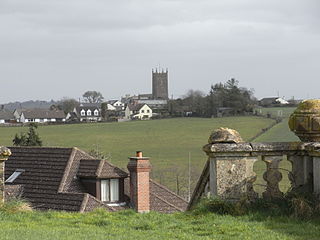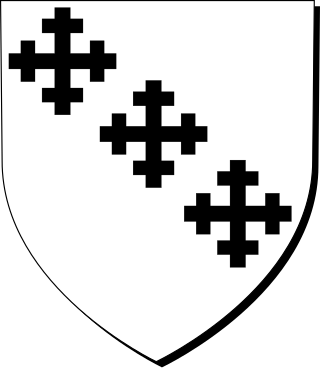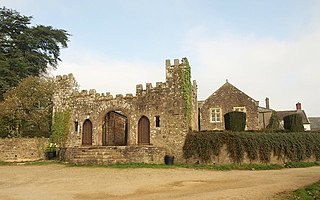
Stafford Henry Northcote, 1st Earl of Iddesleigh, known as Sir Stafford Northcote, Bt from 1851 to 1885, was a British Conservative politician. He served as Chancellor of the Exchequer between 1874 and 1880 and as Foreign Secretary between 1885 and 1886

Earl of Iddesleigh, in the County of Devon, is a title in the Peerage of the United Kingdom. It was created in 1885 for the Conservative politician Sir Stafford Northcote, 8th Baronet, of Pynes in the parish of Upton Pyne near Exeter in Devon and lord of the manor of Iddesleigh, 28 miles north-west of Pynes. He served as President of the Board of Trade, Secretary of State for India, Chancellor of the Exchequer, First Lord of the Treasury and Foreign Secretary and was Joint Leader of the Conservative Party from 1881 to 1885. Northcote was made Viscount St Cyres, of Newton Saint Cyres in the County of Devon, at the same time he was given the earldom. This title is also in the Peerage of the United Kingdom.

Plymtree is a small village and civil parish about 3.5 miles south of the town of Cullompton in the county of Devon, England. The parish is surrounded, clockwise from the north, by the parishes of Broadhembury, Payhembury, Clyst Hydon and Cullompton. In 2001 it had a population of 605, compared to 359 in 1901. The village website provides up to date information about local events http://www.plymtree.org.uk/
The Office of the Lord Lieutenant was created during the reign of Henry VIII (1509–1547), taking over the military duties of the Sheriffs and control of the military forces of the Crown. From 1569 there was provision for the appointment of Deputy Lieutenants, and in 1662 the Lord-Lieutenant was given entire control of the militia. The Forces Act of 1871 transferred this function back to the Crown, and in 1921, the office lost its power to call upon men of the County to fight in case of need. Since 1711 all the Lord Lieutenants have also been Custos Rotulorum of Devon.

Beaford is a village and civil parish in the Torridge district of Devon, England. The village is about five miles south-east of Great Torrington, on the A3124 road towards Exeter. According to the 2001 census the parish had a population of 393, compared to 428 in 1901. The western boundary of the parish is formed by the River Torridge and it is surrounded, clockwise from the north, by the parishes of St Giles in the Wood, Roborough, Ashreigney, Dolton, Merton and Little Torrington.

Newton St Cyres is a village, civil parish former manor and former ecclesiastical parish in Mid Devon, in the English county of Devon, located between Crediton and Exeter. It had a population of 562 at the 2011 Census. The village is part of the Newbrooke electoral ward. The ward population at the above census was 1,520. Almost destroyed by fire in the early 1960s, its main point of interest is the Parish Church, built in the 15th century and dedicated to the martyrs St. Cyriac and his mother St. Julitta. Most of the church is in early Perpendicular style, built of local reddish 'trap', a volcanic stone from quarries at Posbury, with the exception of the nave pillars, which are of Beer stone. It contains the monument with standing effigy of John Northcote (1570-1632) of Hayne, lord of the manor of Newton St Cyres. Newton St Cyres railway station is on the Tarka Line from Exeter to Barnstaple and the Dartmoor Line from Exeter to Okehampton, but is located approximately 0.5 miles outside the village centre, and receives an infrequent service.

Upton Pyne is a parish and village in Devon, England. The parish lies just north west of Exeter, mainly between the River Exe and River Creedy. The village is located north of Cowley and west of Brampford Speke and Stoke Canon. It has a population of 539.

Brampford Speke is a small village in Devon, 4 miles (6 km) to the north of Exeter. The population is 419. It is located on red sandstone cliffs overlooking the river Exe. Its sister village of Upton Pyne lies to its southwest, and Stoke Canon is across the river, to the east. To the south is the hamlet of Cowley with its chapel of ease, which was formerly part of the ecclesiastical parish of Brampford Speke.

St Giles in the Wood is a village and civil parish in the Torridge district of Devon, England. The village lies about 2.5 miles east of the town of Great Torrington, and the parish, which had a population of 566 in 2001 compared with 623 in 1901, is surrounded clockwise from the north by the parishes of Huntshaw, Yarnscombe, High Bickington, Roborough, Beaford, Little Torrington and Great Torrington. Most of the Victorian terraced cottages in the village, on the east side of the church, were built by the Rolle Estate.

Burrington is a village and civil parish in North Devon in England. In 2001 the population was 538.

Sir Henry Northcote, 5th Baronet, of Hayne in the parish of Newton St Cyres near Crediton in Devon, later of Pynes in the parish of Upton Pyne, Devon, was a Member of Parliament for Exeter from 1735 until his death in 1743.

Tawstock is a village, civil parish and former manor in North Devon in the English county of Devon, England. The parish is surrounded clockwise from the north by the parishes of Barnstaple, Bishop's Tawton, Atherington, Yarnscombe, Horwood, Lovacott and Newton Tracey and Fremington. In 2001 it had a population of 2,093. The estimated population in June 2019 was 2,372.

Iddesleigh is a village and civil parish in the county of Devon, England. The settlement has ancient origins and is listed in the Domesday Book. The village lies on the B3217 road, roughly central in its parish of around 2,900 acres (1,200 ha), about 8 miles (13 km) north of the town of Okehampton.

East Down is a village and civil parish in the Barnstaple district of Devon, England. It includes the hamlets of Churchill, Shortacombe, Brockham and Clifton. The parish contains a church, pub and manor house.

Huntsham is a small village and civil parish, formerly a manor and ecclesiastical parish, in the Mid Devon district of Devon, England. The nearest town is Tiverton, about 5.8 miles (9.3 km) south-west of the village. The parish is surrounded clockwise from the north by the parishes of Bampton, Hockworthy, Uplowman and Tiverton; it is bounded on the east by the River Lowman and by a minor road on Bampton Down to the north west, where it reaches a maximum height of 914 feet (279 m). In 2001 the population of the parish was 138, down from 222 in 1901.

Sir Henry Northcote, 4th Baronet (1655–1730) was an English baronet from Devon. He was by profession a doctor of medicine. His great-great-great-grandson was Stafford Northcote, 1st Earl of Iddesleigh (1818–1887).

Stafford is an historic manor in the parish of Dolton in Devon, England. The present manor house known as Stafford Barton is a grade II* listed building. A house of some form has existed on the manor probably since the Norman Conquest in the 11th century. Surviving walls can be dated to the 16th century. Many additions and renovations have taken place in the intervening years, and in the early 20th century Charles Luxmoore made many alterations and extensions and imported several major architectural features from ancient local mansions undergoing demolition so that "it has become somewhat difficult to discern its original form". In the nineteenth century the estate was very substantial, with 400 acres of associated farmland and a large staff, and by 1956, at the end of the Luxmoore tenure, it had grown to 1,460 acres with 7 farms, several cottages and smallholdings.

Dowrich is an historic estate in the parish of Sandford, on the River Creedy, three miles north-east of Crediton in Devon, England. Between the 12th century and 1717 it was the seat of the ancient gentry family of Dowrish which took its name from the estate where it had become established before the reign of King John (1199–1216), when it built a castle keep on the site. A 15th century gatehouse survives there today, next to the ancient mansion house.

John Quicke (1724–1776) of Newton House in the parish of Newton St Cyres in Devon, was Sheriff of Devon in 1757.
Walter Stafford Northcote, 2nd Earl of Iddesleigh CB was an English landowner, peer, civil servant, and author, a member of the House of Lords from 1887 until his death.


















